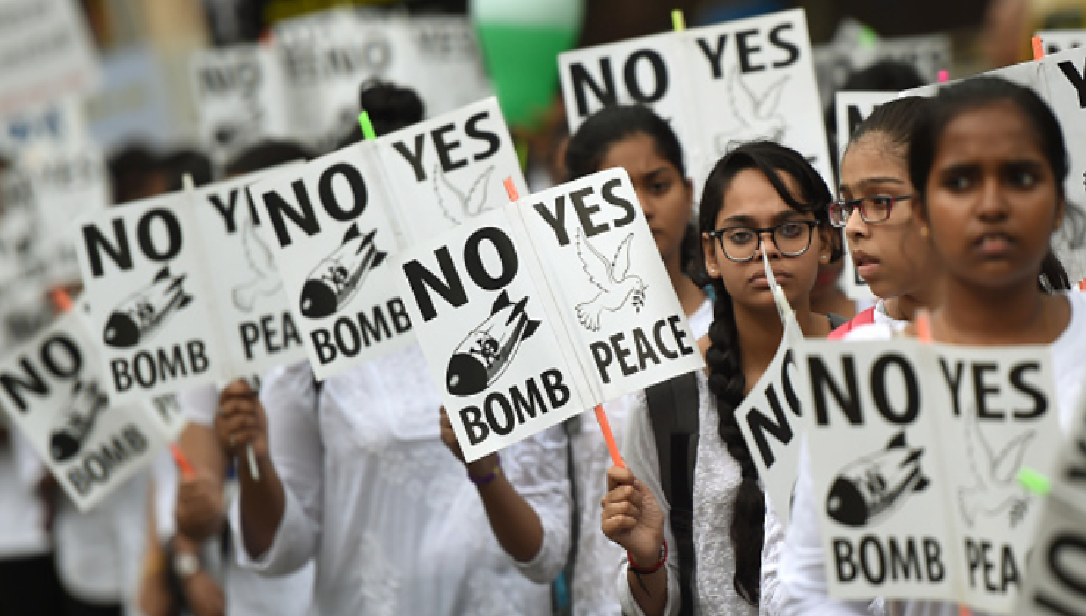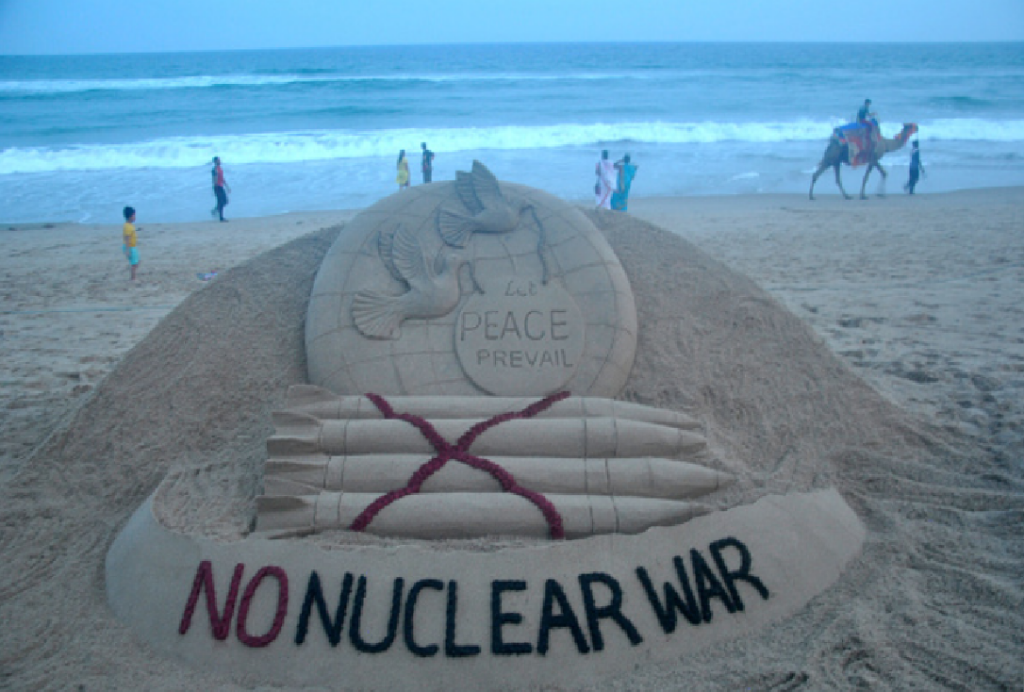
In 2019, while addressing an election rally, Indian Prime Minister Narendra Modi stated a fiery public remark, “every other day they [Pakistan] used to say ‘we have nuclear button, we have nuclear button.’ What do we have then? Have we kept it for Diwali (a mega Indian festival celebrated with extensive use of firecrackers)?” His statement is just one example of India and Pakistan’s exaggerated rhetoric around their nuclear rivalry.
Only a year earlier, Pakistani Minister Shazia Marri issued a flaming statement at a presser: “India should not forget that Pakistan has an atom bomb. Our nuclear status is not meant to remain silent. We will not back down if the need arises.” Hours later, Marri walked the statement back, tweeting, “Pakistan is a responsible nuclear state. Some elements in Indian media trying to create panic.” His remarks sparked an Indian response, with Minister of State for External Affairs V. Muraleedharan claiming, “India has the capacity to deal with all these threats. India is not a nation that will back away from anyone’s threats. No one should have any doubts about that.”
These are irresponsible statements coming from responsible politicians. Further, these rhetorical statements contribute to cultivating nuclear war psychology. Given the risks of nuclear use, the statements indicate that New Delhi and Islamabad need to be made aware of their responsibilities to dissuade toxic nuclear tensions or are deliberately bypassing established nuclear strategic knowledge. In other words, responsible nuclear states should strategize to stigmatize the bomb. Most importantly, these statements undermine the essential ingredients of nuclear responsibilities.
Nuclear responsibilities are defined as a set of extraordinary obligations and reasoning of the nuclear weapon states to exercise restraint in nuclear posturing and proliferation activities to avoid nuclear crises and avert a nuclear arms race. A nuclear responsibilities framework demands that states prioritize behaviors that reinforce credible deterrence postures and doctrines, reduce nuclear risks, and create the conditions for disarmament. Given the catastrophic risks of escalation, the political leadership in both India and Pakistan should refrain from acts of nuclear irresponsibility and demonstrate their respect for nuclear safety and security norms.
Nuclear Responsibilities Framework
Since the advent of nuclear weapons, scientists, civil society, policymakers, and political leaders have worked to define nuclear responsibilities. However, due to the complex political nature of nuclear technologies, they have failed to develop a universal consensus on definitional elements of nuclear responsibilities. Despite this, the initial thoughts on the responsibilities of nuclear scientists and nations toward humanity have provided a strong foundation for forming a nuclear epistemic community for this cause. During World War II, President Truman’s Secretary of War, Henry Stimson, invoked nuclear responsibility as a locus of all nuclear decisions. The founders of the Pugwash conferences have motivated many experts and organizations to manage nuclear risks by realizing nuclear responsibilities. Per these frameworks, states with nuclear weapons should exercise self-restraint in proliferation and arms racing, showcase their disarmament commitments, build a culture of nuclear security, and stigmatize nuclear use.
Given the catastrophic risks of escalation, the political leadership in both India and Pakistan should refrain from acts of nuclear irresponsibility and demonstrate their respect for nuclear safety and security norms.
Recently, the British American Security Information Council (BASIC) and the Institute for Conflict, Cooperation and Security (ICCS) jointly developed a nuclear responsibilities approach to reframe thinking, talking, and writing on nuclear issues. This nuclear responsibilities toolkit relocates nuclear logic from the actor’s right and necessity to acquire and augment nuclear stockpiles to the actor’s responsibilities to handle these weapons, devising mechanisms to deliver their responsibilities, and illustrating mutual obligations of the acquired weapons. It is also a multilayered framework to provide alternative education on nuclear matters.
By adopting this framework, the international community can provide overarching principles to transcend the toxic dilemma of who is a responsible or irresponsible nuclear state. For example, this framework helps build a collective nuclear vocabulary and prevents blame culture. At the regional level, this exercise is helpful to bring New Delhi and Islamabad together to assess their nuclear security apparatus and narratives as well as their fallouts. If national leaders were to adopt and promote this framework, political leaders might refrain from making euphoria-driven nuclear button statements.
Existing South Asian Nuclear Culture Lacks Nuclear Responsibilities
When politicians in India and Pakistan remind one another of the nuclear button and equate nuclear weapons with Diwali firecrackers, they reinforce South Asian atomic culture. This atomic culture has facilitated the acquisition of nuclear technology with chauvinistic pride and a symbol of supreme power for political independence. It has limited space for negotiating potential threats of nuclear exchanges and shared responsibilities of hostile SNW. For instance, New Delhi and Islamabad have not been able to build robust institutional arrangements for Nuclear Confidence Building Measures (NCBMs).
India and Pakistan need a better cooperation record for joint nuclear doctrine formulations and identifying implementation procedures. Furthermore, their ambiguous doctrines, postures, and accidents may escalate nuclear instability. For instance, during the Brahmos missile misfire, Indian political leadership failed to establish communication with their Pakistani counterparts. Similarly, during the February 2019 crisis, timely U.S. intervention was critical in preventing nuclear escalation between New Delhi and Islamabad.

Furthermore, the caveated No First Use (NFU), context-driven meanings of credibility and minimality, focus on full spectrum nuclear deterrence, and the quest for deploying tactical nuclear weapons increases the potentiality of a nuclear use rather than moving toward nuclear taboo. Further, the absence of transnational nuclear disarmament on the subcontinent, the lack of verifiable measures for nuclear fissile material, and the quest for nuclear superiority do not reflect policies of responsible nuclear states. Responsible political leadership should initiate dialogue to minimize nuclear risks and pause spiraling trends of invoking nuclear threats. Unfortunately, they have minimized discourse, and conditional communications are hard to resume. This atomic culture stimulates nuclear crises and provides cover for risky realities. Thus, these trends and flaming statements constitute nuclear irresponsibility.
Tasks Ahead and Takeaways
A nuclear responsibilities toolkit can help the South Asian atomic public and state to realize their nuclear responsibilities. This realization would infuse nuclear restraint in a heightened nuclear environment and help visualize alternative policy actions. This will be useful in reducing dependency on nuclear weapons to ensure state security and sovereignty. However, the “chronic culture of blame,” a status-sensitive atomic public, an emerging intersection of nuclear and cyber technologies, and the external players’ active role will pose additional challenges to the India-Pakistan nuclear conundrum. As uncertainty and escalatory risks grow, India and Pakistan urgently need to adopt the nuclear responsibilities framework.
At the same time, it is hard to apply and sustain its application. For example, a responsibility framework may not be attractive to policymakers when dialogue between the countries is minimal. A survey of various attempts to apply this model to relocate the focus of nuclear discourse from “rights, blame, suspicion, and distrust” toward “responsibility, cooperation, empathy, and trust” has gained momentum in some academic circles. However, as Rabia Akhtar rightly points out, selling this model to Southern Asian political leaders remains a key challenge.
To build support for the nuclear responsibilities framework in South Asia, organizations and scholars working on the region’s nuclear dynamics must exert their influence to inculcate a nuclear responsibilities framework by organizing workshops, working collaboratively, and suggesting alternative policy prescriptions to the ruling establishment. Scholars speaking at universities and on various media platforms is an easy way to hit political leaders’ ears.
A nuclear responsibilities toolkit can help the South Asian atomic public and state to realize their nuclear responsibilities.
In the long run, independent international organizations and states should initiate a structured dialogue between former policymakers and experts of South Asian nuclear politics under the nuclear responsibilities framework. They can adopt a critical oral history method for knowing each other’s nuclear thinking and decision-making to distill the notion of New Delhi and Islamabad’s nuclear (ir)responsibilities during various stages of nuclear technological advancement and crises.
This way, the nuclear responsibilities framework can alter self-centric and jingoistic nuclear discourse into peace-oriented deterrence and stability narratives and policies. This approach facilitates the realization that their national security priorities have a mutual interest in preventing nuclear Armageddon.
Also Read: The Luck Factor: Preventing Nuclear War in South Asia
***
Click here to read this article in Urdu.
Image 1: Punit Paranjpe/AFP via Getty Images
Image 2: STR/NurPhoto via Getty Images
